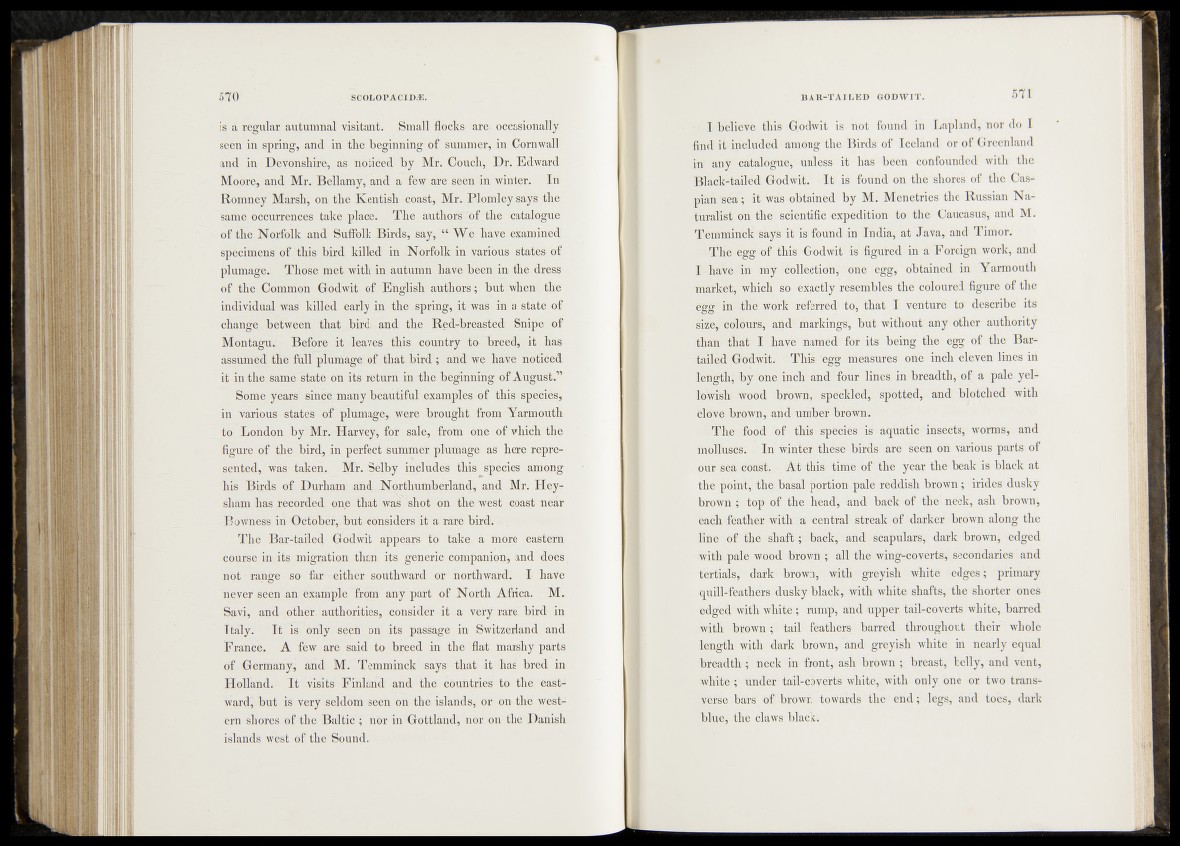
is a regular autumnal visitant. Small flocks are- occasionally
seen in spring, and in the beginning of summer, in Cornwall
and in Devonshire, as noticed by Mr. Couch, Dr. Edward
Moore, and Mr. Bellamy, and. a few are seen in winter. In
Romney Marsh, on the Kentish coast, Mr.. Plomley says the
same occurrences, take place* The authôrs'"6f the catalogue
of the Norfolk and Suffolk Birds, say, 44 We have examined
specimens of this bird killed in -Norfolk in various states of
plumage. Those met with in autumn have been in the dress
of the Common God wit of English authors ; but when* the
individual was killed early in the spring, it was in a state of
change between that bird and tbè Red-breasted Snipe of
Montagu* Before it leaves this country to breed, it has
assumed the full plumage of that bird ; and we have noticed
it in the same state on its return in the beginning of August.”
Some years since many beautiful examples of this spêciès,
in various states of plumage,, were brought, from Yarmouth
to London by Mr. Harveyy for sale, from one of which the
figure of the bird, in perfect summer plumage as here represented,
was taken. Mr. Selby includes this species among
his Birds of, Durham and Northumberland, and. Mr. Hey-
sliam has recorded one that was shot on'the west coast near
•Bowness in October, but considérait a rare bird. - ;
The Bar-tailed Godwit appears to take a more eastern
course in its. migration than its gen eric, companion,and does,
not range so far - either southward or northward. I have
'never seen an example from any part Of-North Africa. M.
Savi, and other, authorities, consider it a very rare bird in
Italy. It is only seen on its passage in Switzerland and
France. A few are said to breed in the flat marshy parts
of Germany, and M. Temminck says that it has" bred in
Holland. It visits Finland and the countries to the east-1'
ward, but is very seldom seen on the islands, or on the western
shores of the Baltic ; nor in Gottland, nor on the Danish
islands west of the Sound.
I believe this G;odwit is not found in Lapland, nor do I
find it included among the Birds of Iceland or of Greenland
in any catalogue, unless it has been confounded with the
Black-tailed Godwit. It is found on the shores of the Caspian
'séa-; it was-obtained by M. Ménetries the Russian Naturalist
on the scientific expedition to the Caucasus, and M.
Temminck says it is found in India, at Java, and Timor.
The egg of this Godwit is figured in a Foreign work, and
I haVe in my-cbllectiohjVtme egg, obtained in Yarmouth
market, which so exactly resembles the coloured figure of the
effff itf thfr! WOrk- referred- to, that I venture to describe its
size",•-colours, a$d markings, but without any other authority
than that I have framed for its -being the egg of the Bar-
tailed Godwit. T h is ‘egg measures one inch eleven lines in
length,’ by one inch' and four lines in breadth* of a pale yellowish
Wood brown, speckled, spotted, and blotched with
Clove brown, and umber brown. .
The food of this fepëciés ;is aquatic insects, worms, and
mollüscS. ; In winter these birds are seen on various parts of
OÏÏt^seacöSSt, At this timèsbf the year the beak is black at
the point, basal portion pale reddish brown ; irides dusky
brown ;|#Èbp^of the head, and back of the • neck, ash brown,
each- feather with a central streak of darker brown along the
line of the shaft; back, arid* SCapulars, dark brown, edged
with pale wood' brown all the wing-coverts* secondaries and
'rfértials, darfcbbrdwn, with greyish white edges; primary
qUill-feathers -dusky black, with white shafts, the shorter ones
-edged-with white; rump, and upper tail-coverts white, barred
with brown; tail feathers barred throughout their whole
length With dark brown, and greyish white in nearly equal
breadth ; neck fin front, ash brown ;. breast, belly, and vent,
white ; under tail-cöverts white,, with only one or two trans-
vlrse bars of brown towards the end; legs, and toes, dark
blue, the claws black.